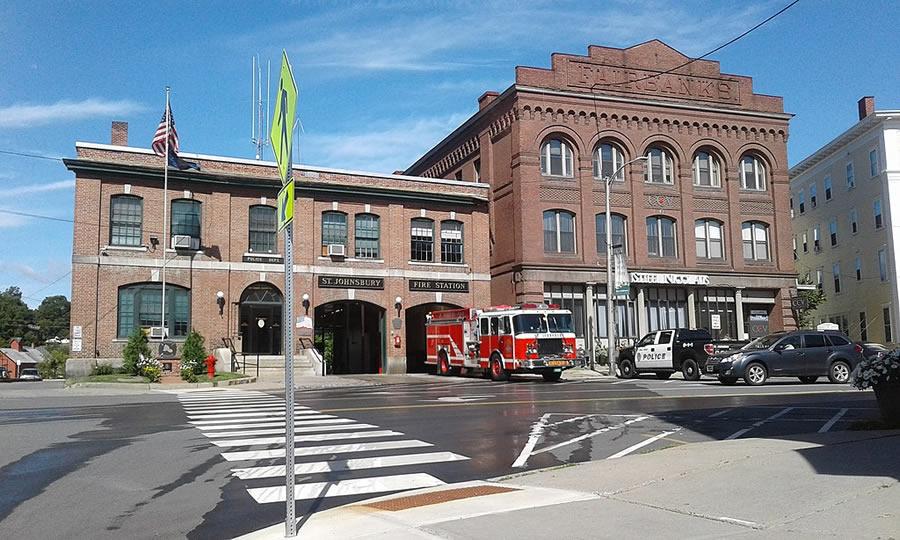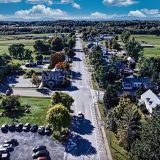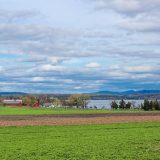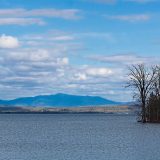A Unique Name St. Johnsbury, Vermont and History
A Few Characteristics of St. Johnsbury, VT
St. Johnsbury, VT is the Shire town of Caledonia County. St. Johnsbury sits at an altitude of 697 feet, 72*, 01′ West and 44* 25′ North. Bordering towns are Waterford, Kirby, Lyndon, Danville and Barnet. The Town lies about 45 miles south of the Canadian border and has an area of about 21,000 acres. The population in 1995 (U.S.Census of Population & Housing Estimates) is 7,741, with 3,596 year round housing units and 19 seasonal units.
St. Johnsbury is located at the confluence of the Passumpsic, Moose and Sleeper's Rivers
The Town is marked by a sharp difference in elevation. The principal business district is concentrated on Railroad Street in the Passumpsic Valley. Main Street, which runs parallel to Railroad Street, lies on a broad plateau, known as the Plain. Fine homes and prominent public buildings line Main Street. The two levels of the Town are connected by the steep and winding Eastern Avenue, also lined with businesses. The town is the largest in northeastern Vermont and has more diverse interests than commonly found in other towns in this area. The long-term presence of particular industries has influenced the evolution of the Town's social character and architectural style.
St. Johnsbury flourished as an industrial town at the height of the Victorian era. Many consider St. Johnsbury the quintessential Victorian, industrial city, including the paternalism of the Fairbanks family and its anti-union attitude. In 1891 St. Johnsbury Illustrated was printed, a review of the town's business, social, literary and educational facilities that provides glimpses of the Town's picturesque surroundings.
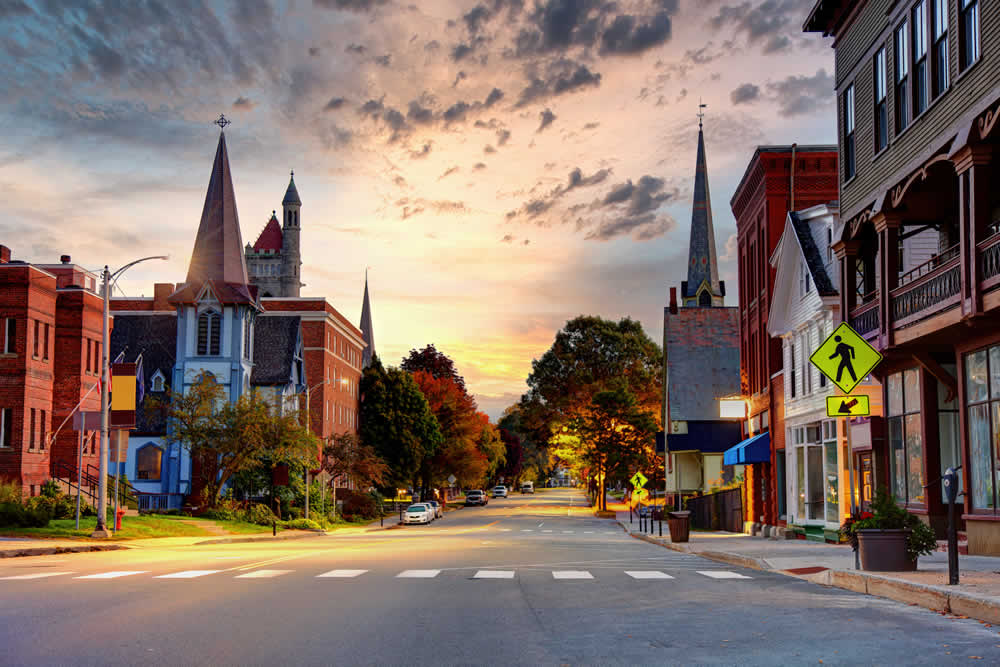
The completion of Interstates I-93 and I-95 has made the area more accessible, causing real estate costs to rise.
Civic structure of St Johnsbury, Vermont
King George granted the first charter in 1770 to Bessborough, later changed to Dunmore. There were few settlers until 1786 when Governor Chittenden granted a charter to Jonathan Arnold from Rhode Island. Arnold and his partners were from the same group of people that were granted a charter for Lyndon ten years before.
The first settlers were four men of the Adams' family, two Trescotts and one each of the Cole, Doolittle, Todd and Nichols families. St. Johnsbury's first town meeting was held in Dr. Arnold's house on June 21, 1790. The first US Census in 1790/91 lists 34 families and 143 inhabitants. There was a steady growth in population during the next century, 663 in 1800, 1334 in 1810 up to 7010 in 1900. In 1792 St. Johnsbury and other towns were set off from Orange County to form the new Caledonia County. In 1856 the County seat was moved from Danville to St. Johnsbury.
The Vermont Legislature granted St. Johnsbury permission to become a city, but the voters declined. The town operates with selectmen and a manager.
What's in a name?
St. Johnsbury was named after Michel Guillaume St. Jean de Vrevecoeur, who was also known as J. Hector St. John, author of “Letters from an American Farmer”. St. John was a friend of George Washington and Ben Franklin, as well as a correspondent of Ethan Allen. He had an enthusiasm for the Republic of Vermont and for place names. He suggested the names Vergennes, Danville and St. Johnsbury. Realizing that several places already bore the name of St. John, J. Hector suggested the longer name, St. Johnsbury, which remains the only place with that name in the world. St. John became a naturalized citizen of the new country and in 1793 he was appointed to the post of French Consul in New York City.
Dr. Arnold, a surveyor, and a crew were surveying along the West Branch of the Passumpsic where the scale factory was later built. As the story goes, when the group traveled away from the river, they left their provisions, including certain necessary stimulants, with Thomas Todd. When they returned, Todd was rolled up against a log on the riverbank, sound asleep. Arnold woke him with a loud shout and made a proclamation, “let this branch be known forever by the name of Sleeper's River”.
The station area of the Canadian Pacific Railroad was called Centervale. Also, before the village of St. Johnsbury engulfed them, there were the districts of Fairbanks, Paddock and Summerville all named for prominent business people of the era. During the last years of the 19th Century, the area in East St. Johnsbury near the railroad station was known as Griswold Station, for the stationmaster.
On the Danville town line there was a village called Goss Hollow, named for David Goss who built the mills on the Sleeper's River. The Plain, the upland pasture in the village, was once known as the “Gates of the Kingdom“. There was also once a hamlet called Coles Corner, a common St. Johnsbury family name.
Water Resources
The Passumpsic River flows southward through the center of town. Near the southwest corner of town, the Moose River feeds into the Passumpsic from the east and the Sleeper's River flows in from the west. Nichols Pond is located in St. Johnsbury.
Mountains, Hills, Wetlands, etc.
The hills of St. Johnsbury are all 1500′ or lower: Saddleback, Mt. Pisgah, Hooker Hill, Bible Hill, Crow Hill and The Knob.
Land Use
The early settlers made use of the abundant waterpower to operate many different industries: sawmills, gristmills, starch factories, tanneries, foundries, hemp works, woolen mills, a fork and hoe factory, and the Fairbanks Iron Works which manufactured plows, stoves, carriages and the world-famous platform scales. The settlers also gathered sap from the maple trees for syrup and, in the early 1900s, maple products became an important industry.
In 1971 the Carl Lawrence Farm was given the Century Farm Award. The award acknowledges 100 years or more of ownership in the same family. John Ide, great, great, great, and grandfather of Carl Lawrence settled the land in 1792. Other members of the family were founders of the first Grange in Vermont.
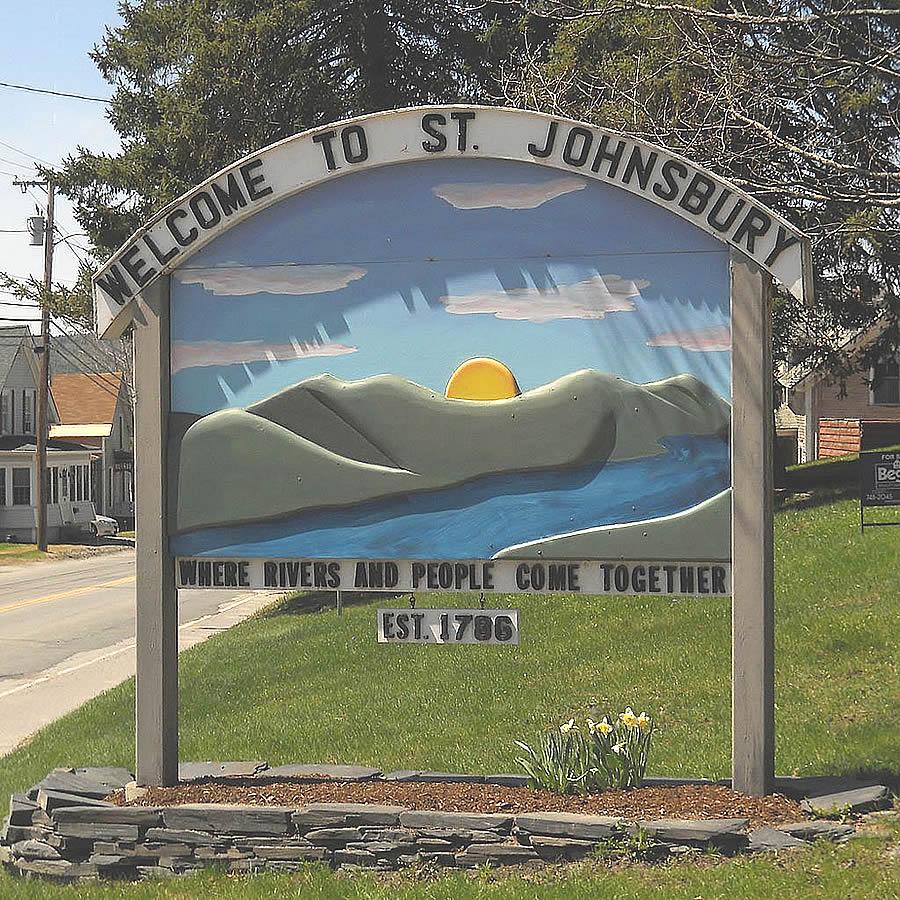
St. Johnsbury is the site of the largest and most continuous esker in the region. An esker is a long, low, typically sinuous ridge of sand and gravel deposited along the course of a stream that tunneled through a wasting ice sheet. The oldest and most beautiful section of the town, the Plain, is on the crest of the esker and US Rt. 2 descends its steep flank along Eastern Avenue. The materials and cross sections of the esker are exposed in a sand and gravel pit at the south end of Main Street. Several other quarries operate along its 24-mile length along the Passumpsic to the north. Clear, clay-free materials of eskers are excellent for concrete and. Asphalt aggregates, roadbeds and other construction uses.
The Passumpsic River flows southward through the center of town. Near the southwest corner of town, the Moose River feeds into the Passumpsic from the east and the Sleeper's River flows in from the west. Nichols Pond is located in St. Johnsbury.
St. Johnsbury Businesses and History
The making of potash, primarily for the making of fertilizer, was the first industry in St. Johnsbury.
The Paddock Iron Works was established in 1828. The foundry used iron ore from Troy, bog iron from Lancaster, New Hampshire, and charcoal produced from St. Johnsbury trees. Stoves, plows and milling machinery were made.
Major Joseph Fairbanks and his three sons came from Brimfield, Massachusetts in 1815 and built a sawmill on the Sleeper's River. The next year a gristmill was built and the sons employed themselves in a small wheelwright and foundry business, which made carriages, plows, hoes, and pitchforks. In 1834 the brothers, Erastus and Thaddeus, with Joseph P., founded the firm of E. & T. Fairbanks & Company. Thaddeus Fairbanks invented the platform scale, originally used to weigh hemp. As a result of Thaddeus' aggressive marketing of the company's innovative products, the company's volume of business doubled every three years.
St. Johnsbury expanded as the scale, maple, and wood products industries expanded. The quick growth of St. Johnsbury resulted in its becoming the county seat in 1856, a railroad junction, and an industrial, commercial and cultural crossroads of the region. It remains so today.
The Ide Company (now Blue Seal Feeds) is the Town's oldest business and the oldest Grain Company in New England. The company started out in Passumpsic in 1813 and moved to St. Johnsbury in 1879. For 164 years the business remained in the Ide family.
George C. Cary founded the Cary Maple Sugar Company in 1904. He was successful in promoting the use of maple sugar for flavoring plug tobacco and as a moisturizing and non-fermenting flavoring agent in cigarettes. Mr. Cary built a large plant on Portland Street as well as an adjoining facility, known as Maple Grove Farms of Vermont. The company operates a museum and sugarhouse on the site. St. Johnsbury became known as the maple center of the world.
After 84 years on Railroad Street, the Hovey retail clothing empire is going out of business. Founder Carl Hovey sold his share of the business in 1945 which is located in three historic buildings. This large business retained its rural character; the owners know many customers by name and sometimes by inseam. Other business lost in recent years: St. Johnsbury Trucking, Mardon Industries, and North East Tool. (Burlington Free Press “No Room For Small Retailers” by Molly Walsh, 10/22/95, 1-8A.)
- Other major manufacturers in St. Johnsbury include EHV-Weidmann Industries.
- The Central Vermont Public Service Company provides electricity to St. Johnsbury.
- The “Caledonia Record” provides daily newspaper service. Also published are the “New England Farmer” and “Turf Magazine”.
- St. Johnsbury radio stations are: WSTJ 1340 AM , WNKV 105.5 FM and WSHX FM.
St Johnsbury Railroads
Railroads became a major factor in the growth of St. Johnsbury starting in 1850, at one time four rail lines merged here. Presently St. Johnsbury is served by the Vermont Northern, Maine Central and Canadian Pacific. The former St. Johnsbury and Lake Champlain Railroad was known locally as “St. Jesus and Long Coming”.
Municipal Buildings & Parks
- The Civil War monument in the Main Street Courthouse Park, dedicated in 1868, is an original Italian marble figure designed by Vermonter Larkin Mead and sculpted in Florence, Italy.
- Arnold Park, a small triangle on Main Street, is the site of Jonathan Arnold's home, the first frame building in St. Johnsbury.
- The St. Johnsbury House on Main Street, built in 1851 as a hotel, now serves as senior housing.
The Athenaeum was built as a public library and presented to the town by Horace Fairbanks in 1871. John Davis Hatch of New York designed the elegant Victorian building. The building has high cathedral ceilings, tall windows that brighten the interior, elaborate woodwork, floors with alternating strips of ash and walnut and spiral staircases.
In 1873 the Art Gallery was added. Horace Fairbanks collected works by contemporary American painters and the design of the gallery was determined by his purchase of the enormous ten by fifteen-foot painting by Albert Bierstadt, “The Domes of the Yosemite”. Critics saw the painting's removal from the New York area to St. Johnsbury as a profound loss to civilized culture. In 1965, Time magazine described the gallery as “the United States' oldest unaltered art gallery still standing”.
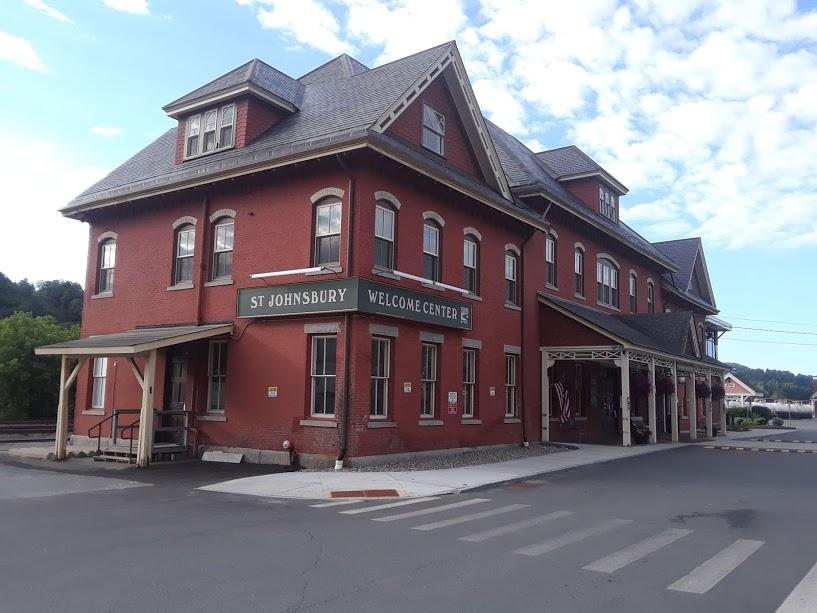
The permanent collection of paintings number one hundred and the library includes approximately 45,000 volumes. The library also has magazines, newspapers, records, video and audiotapes, reproductions of famous paintings and original works by local artists which can be borrowed for hanging in homes, a complete collection of the local newspaper, pamphlets and paperbacks. The library is run by an independent private corporation, but receives an annual appropriation from the Town and in effect serves as the public library for St. Johnsbury.
The Fairbanks Museum and Planetarium
Franklin Fairbanks built the Fairbanks Museum and Planetarium, a museum of natural science and history, in 1891
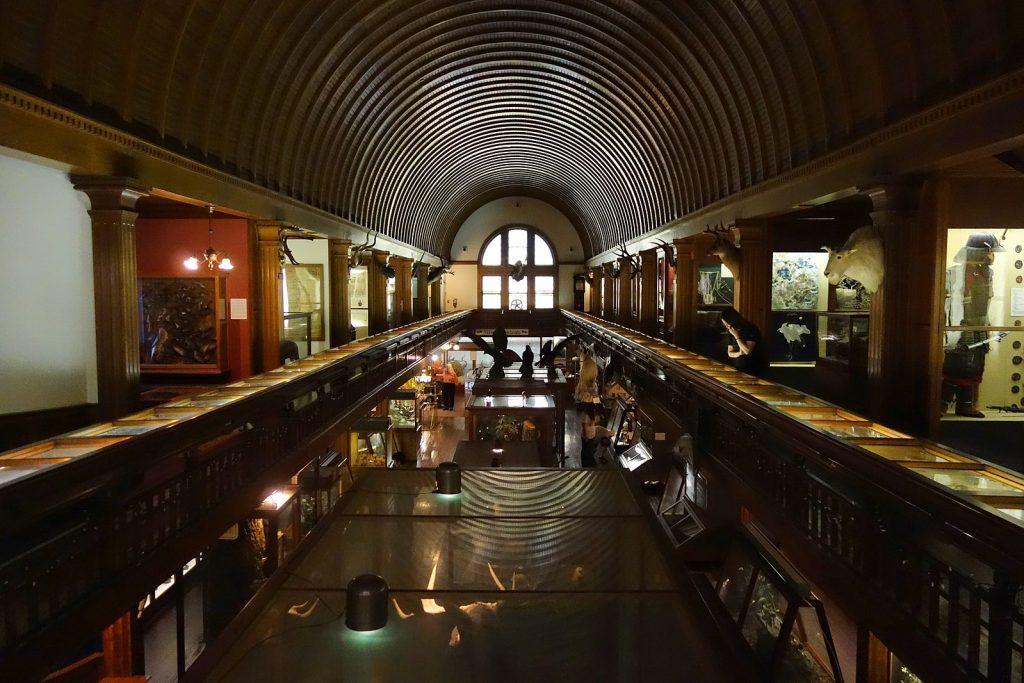
Lambert Packard in the massive, horizontal and rough-textured style of Richardson Romanesque designed the building. In addition to designing industrial buildings for Fairbanks, he also designed six public buildings, two theaters, five schools, three churches and seventeen residences.
Franklin Fairbanks founded the museum to house his collections of rocks, shells, fossils, birds, animals and artifacts from around the world and to put them to active service in the educational life of his community. The museum has the largest display of mounted birds and mammals in northern New England and collections and exhibits related to the history of St. Johnsbury. The museum also houses the Northern New England Weather Center, a Planetarium and offers educational services to over 25,000 children annually.
There is a clock on the corner of Main and Eastern Avenues which once was in Grand Central Station. It tells time, from time to time.
Local Personalities
The first white man to set foot in the area was Stephen Nash with a party of men in 1755 on a scouting mission looking for Indians. The St. Francis Indians used a route including the Passumpsic River to attack settlements in the south. Nash found no Indians; but kept a complete diary of dates, places and observations as his party made its way up the Connecticut, Passumpsic and Moose Rivers.
Dr. Jonathan Arnold was a famous man in Rhode Island before he came into this northern wilderness in 1787 as prime grantee of St. Johnsbury. He authored and pushed through the Rhode Island legislature on May 4, 1776, an act withdrawing Rhode Island from King George's sovereignty, the first “Declaration of Independence” in the colonies. He was a surgeon in the Continental Army and he was a member of the Continental Congress from 1782 to 1784. He cleared much of his own lot in St. Johnsbury, built the first sawmill, did much surveying, built some roads and bridges, planted and harvested his own vegetables, oats and hay, and built the first frame house in town.
The Fairbanks Family
For over three generations the town of St. Johnsbury prospered and grew under the care, devotion and generosity of the Fairbanks Family. Joseph Fairbanks came to St. Johnsbury in 1815. His son Thaddeus invented the platform scale and with his brother Erastus founded the E. & T. Fairbanks Scale Company in 1830. A third son, Joseph worked with his brothers for a time. From this company sprang the genius and fortune that made St. Johnsbury an important economic crossroads well into the 20th. century. In the mid 1800's, iron ore, the chief material used in scale manufacturing, became difficult to find. Recognizing both a need and an opportunity, Thaddeus and Erastus created the first railroad routes that traveled east to New Hampshire and west to Lake Champlain, thereby enabling ore mined in Michigan to be exported to Vermont. The Fairbanks brothers also spurred the railroad route that ran north from White River Junction and completed the connection between Boston and Montreal. Erastus was a genius at sales and marketing, sending agents across the country and the world, selling so many scales of the highest quality that the Fairbanks became the scale by which all others were measured.
The Fairbanks were also involved in State politics. Both Erastus and his son Horace served as governors and another son, Franklin served in the Vermont legislature. Governor Erastus Fairbanks influenced the moving of the county seat from Danville to St. Johnsbury. Horace Fairbanks built the Athenaeum, his brother Franklin, the Museum, and the family founded the Academy and was involved with the building of churches and other Municipal buildings. The Fairbanks family created St. Johnsbury as the commercial hub and the cultural core of the area.
Robert Holbrook Smith (Dr. Bob) of St. Johnsbury along with William Wilson of East Dorset founded Alcoholics Anonymous in 1935.
John Pitcher, nationally acclaimed naturalist and artist lives in St. Johnsbury. Pitcher is known for his exceptional design, color, and detail and intimate knowledge of wildlife and wild places, which brings life to his subjects. The artist is represented by Applejack Limited Editions of Manchester. (Times Argus, 6/25/95, 11).
Note: This series is available courtesy of the Center For Rural Studies, a nonprofit, fee-for-service research organization which addresses social, economic, and resource-based problems of rural people and communities. We would like to thank them for the use of this information and would like to refer you to [email protected] for additional info or comments.
Thank you for reading this post, don't forget to subscribe to our email list for the latest news!


